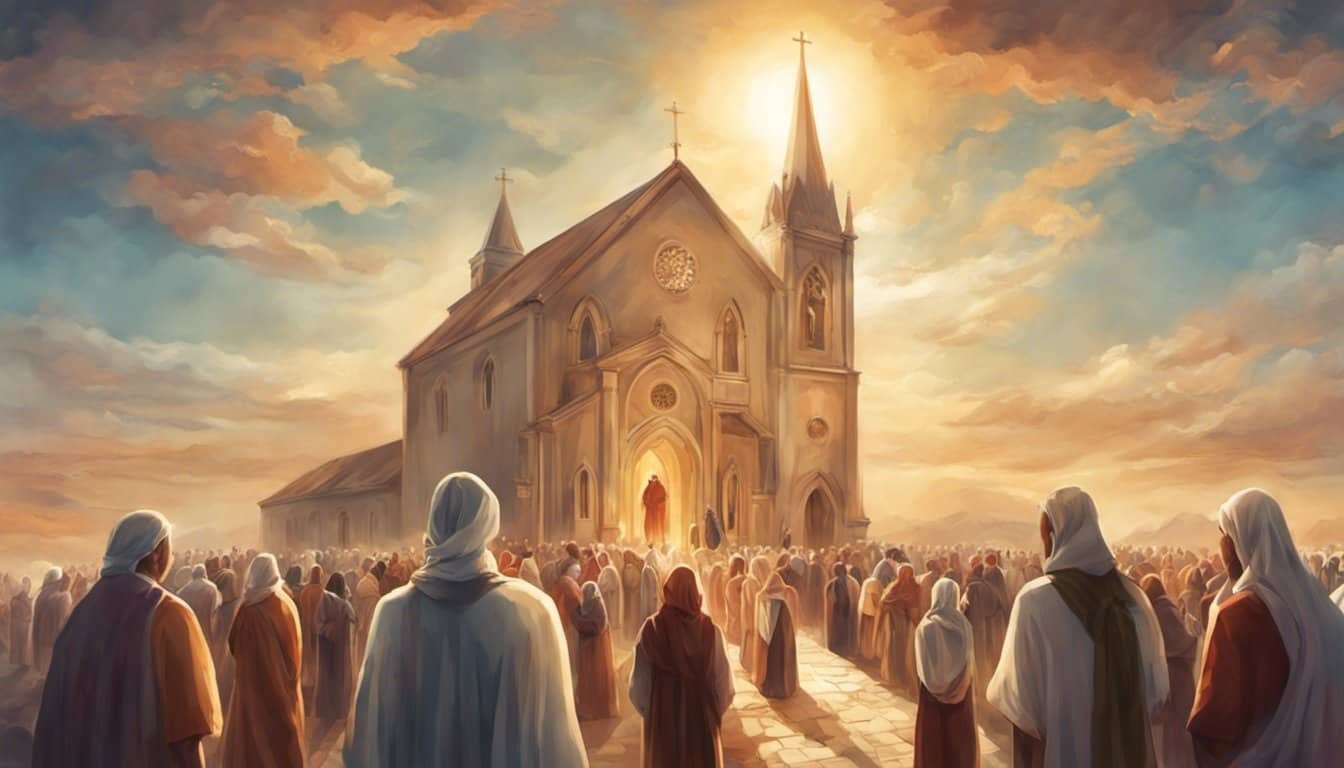The book of Revelation is full of powerful imagery and symbolism, and one of the most enigmatic passages is the War in Heaven described in chapter 12. It depicts an epic struggle between Satan and his fallen angels and Michael and his army of angels. Although this battle has many layers of meaning and interpretation, it is a fascinating look into the spiritual realm and the cosmic conflict between good and evil. In this post, we’ll explore the theological and historical context of this war and the symbols involved to gain a deeper understanding of its message. Read on to uncover the hidden truths of this apocalyptic vision.
History and Context of the Book of Revelation
Before we dive into the war in heaven described in Revelation 12, it’s important to understand the historical and cultural context of the book as a whole. The Book of Revelation (also known as the Apocalypse of John) is the last book of the New Testament and was likely written by John the Apostle towards the end of his life, during a time of intense persecution of Christians by the Roman Empire.

The book is written in a style known as apocalyptic literature, a genre popular in Jewish and early Christian writing that uses symbolic imagery and language to reveal and interpret divine prophecy. The book contains visions and messages that John received from God, revealing the ultimate triumph of God over evil and the establishment of a new heaven and new earth.
The Book of Revelation can be divided into three main sections: the letters to the seven churches, the visions of judgment, and the visions of future events. The war in heaven in Revelation 12 falls under the second section, which focuses on the judgment of evil and the forces of Satan.

To interpret the war in heaven and its role in Revelation, it’s important to understand the context in which it was written. The Book of Revelation was likely written during a time of intense persecution, when Christians were being martyred for their faith. The visions and symbols in the book provided comfort and hope to these early Christians by revealing that God was in control and would ultimately triumph over evil.
Understanding the cultural and historical context of the Book of Revelation can help us better interpret the symbolic language used in the book, including the war in heaven described in Revelation 12. In the next section, we will take a closer look at the imagery and symbolism in this chapter.
To sum it up, the Book of Revelation was written in a time of persecution and uses apocalyptic literature to reveal and interpret divine prophecy. The war in heaven in Revelation 12 falls under the visions of judgment, which provided comfort and hope to early Christians. Understanding the historical and cultural context of the book is crucial to interpreting its symbolic language.
The Imagery and Symbolism in Revelation 12
As one of the most captivating and intriguing books of the Bible, Revelation 12 certainly poses questions as to what it actually means to its readers. The chapter is loaded with religious symbolism, which adds to the mystery and excitement.
Revelation 12 is a symbolic representation of the conflict between good and evil, light and darkness, and God and Satan. The imagery used to describe these forces is striking and creates vivid mental pictures for the reader. For instance, the chapter depicts Satan as a great dragon. The image of a dragon is a powerful one in ancient mythologies, representing chaos, destruction, and terror.
The woman described in the book is also a symbol, representing God’s people or the church. This imagery is a significant representation as it portrays the church as a nurturer, a life-giving force that nourishes and protects her children. The woman’s child is symbolic of Christ himself, who is ultimately the one that overcomes the dragon and triumphs over evil.
Revelation 12 continues to use strong religious symbolism and imagery throughout the chapter. The image of Michael the Archangel wearing armor and fighting against Satan shows us that he is not only a messenger of the Lord but also a warrior who fights for the truth, justice, and righteousness.
Moreover, the chapter depicts a war in heaven, portraying the cosmic conflict between God and Satan. This war illustrates how Satan was cast down from heaven, making him the great adversary against the Lord and his purposes in the world.
The imagery and symbolism used in Revelation 12 is exceptional. These symbols hold up a mirror to the spiritual realities that surround us and influence our daily lives. Revelation 12 reminds us that there is a real battle occurring in the spiritual realm between good and evil, and through it all, Christ is victorious.

In conclusion, Revelation 12 is a chapter of the Bible rich in symbolism and imagery. It uses these tools to illustrate spiritual truths in a way that appeals to our senses and captivates our imaginations. Understanding the symbolism in this chapter helps us to decipher the meaning behind it better and appreciate its relevance today. In essence, it teaches us that behind every conflict, there is a cosmic battle going on, and recognizing this is our first move towards living in victory over the adversary.
A Closer Look at Satan and His Role in the War in Heaven
Revelation 12 provides a depiction of a cosmic conflict that took place in heaven. The chapter portrays a fierce battle between the archangel Michael, who is the leader of God’s heavenly army, and Satan, the enemy of God. The passage is packed with religious symbolism and imagery, shedding light on the conflict between good and evil that is central to Christian theology.
Satan, also known as the devil and Lucifer, is a fallen angel who rebelled against God and was cast out of heaven. In Revelation 12, he is portrayed as a formidable adversary, with his army of angels, who seeks to defeat Michael and his forces. The war in heaven represents the eternal struggle between God and his archangel Michael against Satan and his demons.
The imagery and symbolism used in Revelation 12 help us understand Satan’s role in this conflict. The devil is depicted as a dragon, a creature of immense power, and cunning. He is also referred to as the “ancient serpent,” alluding to his role in the temptation of Adam and Eve in the Garden of Eden. Additionally, Satan is portrayed as the “accuser of the brethren,” one who brings false accusations and slander against God’s people.
But despite Satan’s power and influence, he is eventually defeated by Michael and his heavenly forces. The devil is cast out of heaven and his army of fallen angels is flung down to earth. Satan’s defeat demonstrates that God is stronger than evil and that His power is limitless. It also highlights the importance of faith and trust in God, who will always be our protector and guide in times of trouble.
In conclusion, the war in heaven depicted in Revelation 12 provides valuable insights into the conflict between good and evil, highlighting the role of Satan as the adversary of God and the importance of faith in God’s protection. As Christians, we must be aware of the spiritual warfare that takes place around us and trust in God’s power to overcome evil.
Understanding the Role of Michael and the Angels
In the cosmic conflict described in Revelation 12, the archangel Michael and the angels play a significant role in defeating Satan and his demonic forces. While their actions may seem like a minor detail in the grand scheme of the war, their involvement highlights the importance of spiritual warfare and the power of the divine.
Michael is mentioned by name only five times in the Bible, but his significance as one of the foremost angels in God’s kingdom cannot be understated. In Jude 1:9, Michael is described as the archangel who contended with the devil over the body of Moses. In Daniel 10:13, Michael is presented as one of the chief princes who come to the aid of Daniel.
In Revelation 12, Michael is depicted as the leader of the heavenly armies who battles against Satan and his minions in the war in heaven. Verse 7 describes a war breaking out in heaven between Michael and his angels and the dragon (Satan) and his angels. Despite the dragon’s best efforts, Michael and his angels prevail and cast out Satan and his followers.
The significance of Michael and the angels’ involvement in the war cannot be understated. They represent the power and authority of God’s kingdom and the ability to combat evil forces. It’s a reminder that we are not alone in our struggles against the spiritual forces of darkness, but have the support of God and his heavenly host.

Additionally, the role of the angels in Revelation 12 highlights the significance of obedient service to God. They willingly follow the commands of Michael, the leader appointed by God, and work together to achieve victory. This underscores the importance of submission to God’s will, even when we may not fully understand his plan.
Understanding the role of Michael and the angels is an important piece in interpreting the cosmic conflict described in Revelation 12. It reminds us of the power of God’s kingdom and the significance of spiritual warfare in our own lives. And it encourages us to remain faithful and obedient to God’s will, knowing that we have the support of his heavenly host.
The Significance of the Woman and Her Child in Revelation 12
Revelation 12 is filled with vivid imagery and symbolism, including that of a woman giving birth to a son who will rule the nations with an iron scepter. This woman is often interpreted as representing both the nation of Israel and the Church, while her child is seen as representing Jesus Christ. Here are some key points about the significance of the woman and her child in Revelation 12:
The woman represents the people of God. Throughout the Bible, God’s people have been described using feminine metaphors, such as the bride of Christ. In Revelation 12, the woman is described as being “clothed with the sun, with the moon under her feet, and on her head a crown of twelve stars”. This imagery links her to the people of Israel, as the sun, moon, and stars were often associated with the patriarchs and matriarchs of Israel in the Old Testament.
The child represents Jesus Christ. The book of Revelation makes several references to Jesus as the one who will “rule all the nations with an iron scepter” (Revelation 2:27, 19:15). The fact that the child in Revelation 12 is described using this same language suggests that he is an allusion to the coming of Christ.
The woman’s struggle with the dragon represents the spiritual conflict between good and evil. In Revelation 12, the woman is pursued by a dragon who seeks to destroy her and her child. This dragon is identified as Satan, who is called “the ancient serpent” and “the devil”. This imagery reflects the ongoing spiritual battle between God’s people and the forces of evil.
The woman’s flight into the wilderness represents the persecution of God’s people. After the dragon fails to devour the woman and her child, he turns his attention to “the rest of her offspring, those who keep the commandments of God and hold to the testimony of Jesus” (Revelation 12:17). These offspring are forced to flee into the wilderness, which represents a place of refuge and safety for God’s people in times of persecution.
The woman’s victory over the dragon points to the ultimate triumph of God’s kingdom. Despite the dragon’s efforts to destroy the woman and her child, she is ultimately victorious through the blood of the Lamb and the word of her testimony (Revelation 12:11). This victory foreshadows the final defeat of Satan and the establishment of God’s kingdom on earth.
Overall, the woman and her child in Revelation 12 represent the people of God and the coming of Christ, while the dragon represents Satan and the forces of evil. The imagery and symbolism in this chapter reflect the ongoing spiritual conflict between good and evil that will ultimately result in the triumph of God’s kingdom.
Interpreting the War in Heaven and its Relevance Today

The War in Heaven detailed in Revelation 12 represents a cosmic conflict between God and Satan and has been a subject of debate among theologians, scholars, and religious adherents. The event speaks about a war that took place in heaven, where Satan was cast down to earth along with his followers.
A common interpretation of the event describes Satan’s rebellion against God, resulting in his expulsion from heaven and him becoming the ruler of this world. In this view, the War in Heaven is seen as the manifestation of the ongoing conflict between good and evil. Satan, who was once a glorious angel of God, challenges God’s rule and seeks to establish his dominion on earth, leading to the fallen state of humanity.
Another view considers the War in Heaven as symbolic of the spiritual warfare between God’s forces and Satan’s followers. This view places the event in the context of the present, where people face constant battles against darkness, temptation, and sin. The War in Heaven reminds us of the power of evil and the need to remain steadfast in faith and commitment to God in times of spiritual turmoil.
The War in Heaven also holds relevance in eschatological discussions about the end times. Some interpretations relate the event to the final battle between good and evil, where Christ and His armies triumph over Satan and his followers. The War in Heaven serves as a reminder of the ultimate triumph of God over evil and His eventual establishment of a new heaven and earth.
In modern times, the War in Heaven holds significant relevance for Christians as it represents the ongoing struggles against personal, social, and global evils. Its imagery and symbolism are powerful and hold meaning that transcends time and culture. The War in Heaven reminds us of the spiritual realm’s existence and the influence of unseen forces in our environment and communities.

Furthermore, the War in Heaven reminds us of the need to remain vigilant and faithful, trusting in God’s divine plan for our salvation and redemption. It challenges us to embrace righteousness and resist the temptations of the world, bearing in mind that the spiritual forces of evil are continually seeking ways to lead us astray.
In summary, the War in Heaven described in Revelation 12 is a crucial event in Christian theology, representing the cosmic conflict between God and Satan. It holds relevance today as a reminder of the need to remain steadfast in faith, resist evil, and trust in God’s divine plan for our lives. Understanding and interpreting the War in Heaven’s significance can help us navigate the present’s challenges and prepare for the future trials we may face.














